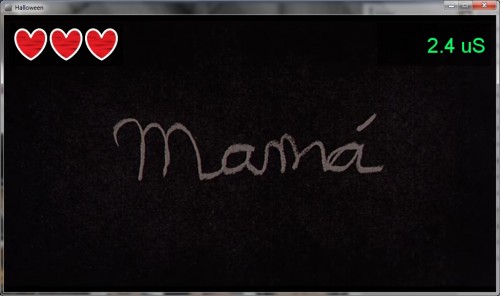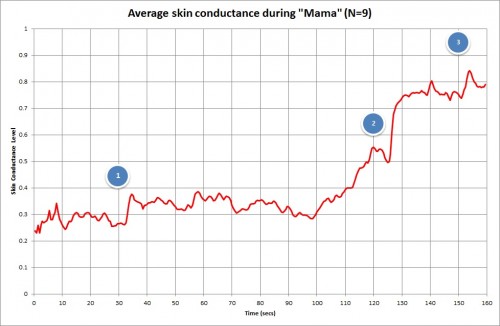Last weekend I was at Oggcamp demoing a mobile GSR sensor using a mini-horror game I quickly whipped up for the event. The game uses a similar mechanic to Dark Escape 4D which I played a couple of months back. Dark Escape is a 2-player light-gun game with competitive biofeedback elements. During play there are several predetermined events which try to shock players into responding physiologically, and the player who responds the least is judged the winner. Its an interesting idea which lends itself well to an arcade game.
Basically I took that mechanic and developed it for a passive 1-player experience, whereby the player is shown a short horror film, during which they have to control their physiological responses to “scary events” I’d marked out in the video. Every time the player failed to control their responses they would lose a life and if they lost all their lives the game was over. For this I chose the horror-short Mama by Andy and Barbara Muschietti which had the sort of scares I was looking for.
In order to assess the player’s response I used several seconds of pre- and post scary event GSR data to generate a change score. If GSR went up the player was said to be scared and lost a life and if it didn’t the player was said to be calm and didn’t lose a life. I originally thought Dark Escape used a similar method of assessment however after going through some of the footage I recorded I couldn’t see any obvious link between the physiological signal and the player’s status.

In all 9 people played the game, and while in this instance I wasn’t collecting user feedback (I was using this as an exercise in rapid-prototyping interaction mechanics with Processing), I did notice their was a lack of player engagement with the biofeedback elements of the interface. I had a similar issue with Dark Escape as the game mechanic is quite passive and provides very little motivation for player engagement as its just an extraneous number displayed on the screen. As a two-player experience Dark Escape doesn’t suffer as much from this i.e. motivated through competition, but as my game was a 1-player experience I wouldn’t benefit from this.
The take-away from this experience was the player-responses I collected to Mama which I’ve included below. I would suggest watching the short before viewing the graph.

The graph represents the average of the normalised skin conductance traces for all 9 players. The icons represent 3 events I’d marked out for assessment, see below. For the first event I didn’t expect much of a response (by comparison to the whole film), as the event was subtle and quiet. The second and third event where the Mama creature chases the children, I was expecting large responses, especially given the accompanying music and sound effects. As can be seen in the graph the largest response, by far, was to the first reveal of the creature, event 2.



Looking at the graph, one thing I didn’t factor into my choice of video was the effect of the increasing tension in the music which comes in at the 80 second mark. This caused the player’s GSR level to slowly increase which had a tendency to throw off the games assessment of the player state for event 2.